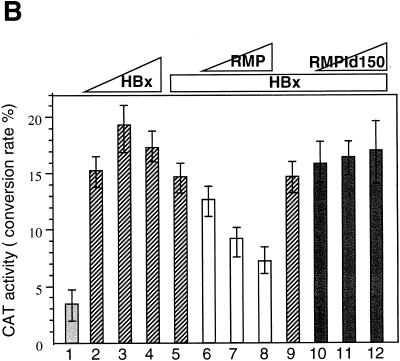FIG. 8.
RMP inhibits HBx transactivation. (A) Transfection of HepG2 cells and CAT assays were described in Materials and Methods. Various amounts of HBx and RMP plasmids were transfected together with the reporter plasmid, pHECx2CAT, in which the CAT gene is under the control of the dimeric sequence of the HBV Enh1 core. The transfected plasmid DNA was 5 μg of pHECx2CAT together with the following: bar 1, 5 μg of pSG5UTPL; bars 2 to 4, 1, 2, and 4 μg of pSG5UTPL-HBx, respectively; bars 5 to 7, 1, 2, and 4 μg of pSG5UTPL-RMP, respectively; bars 8 to 10, 1, 2, and 4 μg of pSG5UTPL-RMP-Id150, respectively; bars 11 to 14, 0, 1, 2, and 4 μg of pSG5UTPL-RMP, respectively, plus 1 μg of pSG5UTPL-HBx; and bars 15 to 18, 0, 1, 2, and 4 μg of pSG5UTPL-RMP-Id150, respectively, plus 1 μg of pSG5UTPL-HBx. HBx counteracted the corepressor activity of RMP in the system in a dose-dependent manner: bars 19 to 22, 0, 1, 3, and 4 μg of pSG5UTPL-HBx, respectively, plus 1 μg of pSG5UTPL-RMP; and bars 23 to 25, 1, 3, and 4 μg of pSG5UTPL-HBx-3D5, respectively, plus 1 μg of pSG5UTPL-RMP. The total amount of DNA added per transfection was adjusted to 10 μg with the control vector, pSG5UTPL. (B) RMP inhibits the transactivation by HBx of the reporter. The NFκBx3CAT harbors a trimeric repeat of the NFκB-binding site, which is responsive to HBx. The transfected plasmid DNA was 5 μg of pNFκBx3CAT together with the following: bar 1, 5 μg of pSG5UTPL; bars 2 to 4, 1, 2, and 3 μg of pSG5UTPL-HBx, respectively; bars 5 to 8, 0, 1, 2, and 3 μg of pSG5UTPL-RMP, respectively, plus 1 μg of pSG5UTPL-HBx; and bars 9 to 12, 0, 1, 2, and 3 μg of pSG5UTPL-RMP-Id150, respectively, plus 1 μg of pSG5UTPL-HBx. The total amount of DNA added per transfection was adjusted to 10 μg with the control vector, pSG5UTPL. Error bars show standard deviations.


